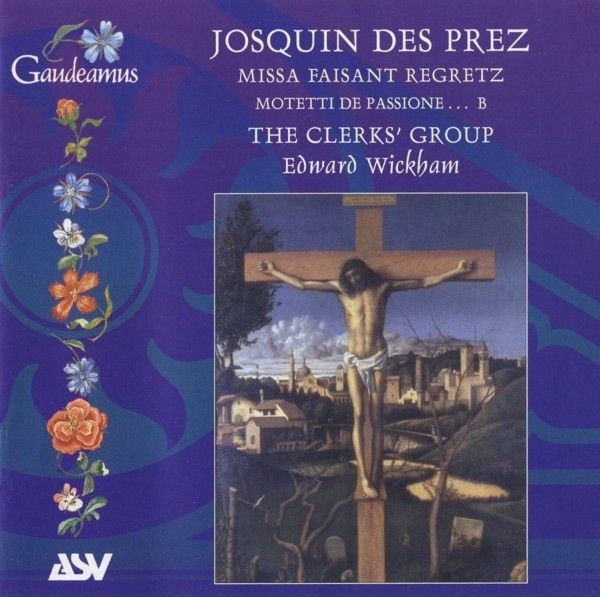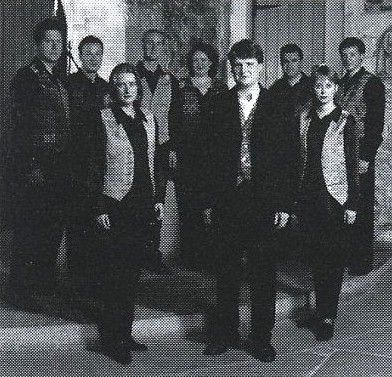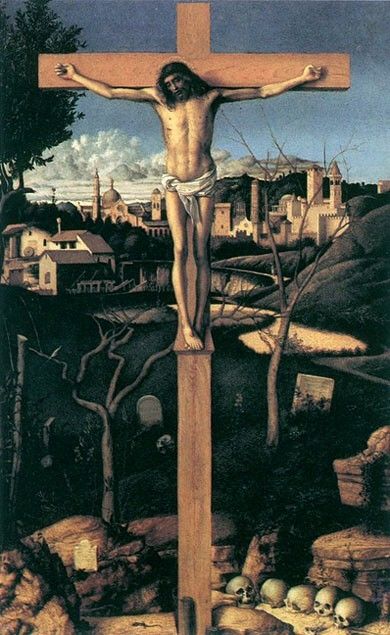JOSQUIN / The Clerks' Group
Missa Faisant Regretz · Motetti from De Passione ... B (1503)

medieval.org
AS&V Gaudeamus 302
2002
JOSQUIN
(c.1455-1521)
from Motetti de Passione ... B (1503)
1. Tu solus qui facis mirabilia [4:02]
2. Domine, non secundum [7:44]
c-h
3. Ave verum corpus [8:23]
a-d
4. O Domine Jesu Christe [4:07]
5. Christem ducem ~ Qui velatus [15:08]
c-h
Walter FRYE
(d.1475)
6. Tout a par moy [7:15]
c, e, f
JOSQUIN
Missa Faisant regretz
c-f
7. Kyrie [2:21]
8. Gloria [3:56]
9. Credo [5:50]
10. Sanctus & Benedictus [5:57]
11. Agnus Dei [4:23]

The Clerks' Group
Edward Wickham
Carys Lane (a), Rebecca Outram (b) — soprano
Lucy Ballard (c), William Missin (d) — alto
Christopher Watson (e), Matthew Vine (f) — tenor
Edward Wickham (g), Robert Macdonald (h) — bass
>
Produced by David Trendell
Recorded by David Wright (Gemini Sound)
Recorded in St Andrew's, West Wratting 14-16 March 2001

The dating game should not be entered
into unadvisedly, lightly or wantonly — especially when it comes
to the music of Josquin Des Prez. The changes in our understanding of
Josquin's biography, and in particular the revelation that the Josquin
of Milan Cathedral in the 1460s was not the famous composer, throw into
doubt some traditional assumptions about the development of Josquin's
style, and indeed the whole history of early Renaissance music. They
also encourage us to think differently about the way the style and
technique of a talented composer such as Josquin might grow and mature.
Central to these assumptions are a group of works which were thought to
be Milanese in style: simple and direct, they are mostly chordal and
are intended to declaim the text in an audible, rhetorical fashion.
Amongst the works in this category one could list Tu solus qui
facis mirabilia, Christum ducem/Qui velatus and O Domine, Jesu
Christe, all of them anthologised in Petrucci's 1503 publication Motetti
de Passione . . . B. The conjunction of this supposedly "simple"
style with the young Josquin's presumed employment at Milan Cathedral
reinforced the impression that these works were examples of a composer
finding his feet. Fortunately, the banishment of the Milan Cathedral
Josquin from the composer's biography enables us to reflect upon and
revise the model of a composer moving from simple, homophonic
composition to more elaborate polyphony (is it not possible that
Josquin, of all composers, could compose in different styles, to suit
different clients, liturgies and circumstances, at the same time?) and
to recognise in these apparently modest works the same sparks of genius
that illuminate Josquin's most ambitious works.
It has been argued that Tu solus qui facis mirabilia was
composed in two stages. Certainly the way it has been preserved in
manuscripts and prints of the early 16th century suggests that the
first half of the motet enjoyed a reputation independent of the second,
and in some sources this one section motet is included as part of
Josquin's own Missa dung aultre amer, to mark the elevation of
the host at Eucharist. That the quotation from the song Dung autre
amer appears only in the second section, supports the hypothesis
that Josquin added this second section when Petrucci — for
commercial publishing purposes — extracted the first half from
its original context. The song quotation was therefore deliberately
written in to this new, freestanding motet, to provide a nostalgic
reference to the original context of the motet.
Domine, non secundum is the most elaborate of the Josquin motets
in Petrucci's 1503 collection, with its contrasts in scoring and
occasionally expansive setting of the text. Richard Sherr has
convincingly argued for this motet's Roman provenance, and certainly
the "Milanese" aspects of the motet are confined to a short passage
powerfully accompanying the words "Quia pauperes facti sumus nimis".
Moreover the ending, with its melismatic treatment of the final word
'"tuum" is more reminiscent of the fantasia-like endings of Johannes
Ockeghem than of the Milanese tradition. Josquin takes his lead here
from the plainchant melody which is paraphrased throughout in the top
line. The same technique is employed in the Ave verum corpus,
which alternates two and three voice passages, the latter simply
augmenting the original two-voice music with a decorative contratenor.
With O Domine Jesu Christe we return to the declamatory,
homophonic approach to text setting which we witnessed in Tu solus
gui facis mirabilia. Often described as a "motet cycle", this is a
setting of the Prayers of St Gregory, which in five sections implores
the crucified Christ for redemption. The rhetorical repetitions of the
text find suitable support in Josquin's music, and yet nothing here is
exactly repeated. Rather, the work is woven together by means of a
series of musical "rhymes", the most recognisable of which is the
rhythmic formula which sets the opening words of each section, "O
Domine Jesu Christe." As the cycle progresses, these rhymes become less
exact, and the fifth section develops into a fully polyphonic motet in
itself, together with an eccentric and florid "Amen".
The rhyming of melodies and rhythms is even more crucial in another
motet cycle, Christum ducem/Qui velatus. This setting of
Passiontide hymns by St Bonaventure is made up of short, repeated
melodies and duos which nevertheless form a larger pattern of themes
connecting the whole cycle. Whether these are instantly recognisable by
the listener or performer is not as important as the fact that this
lengthy work creates a sense of order and coherence through allusion
and repetition. Indeed, this is a fine example of prayer in music: in
the tradition of prayers which quote familiar texts, St Bonaventure's
hymn allude in turn to other hymns such as Conditor alme siderum
and Aetema Christi munera, while Josquin's frequent use of
upper and then lower voice duos, echoing one another, is not unlike
responsorial types of prayer such as the litany. It is understandable
that Petrucci should wish to include such a work in a volume which he
hoped would be bought by amateur musicians, possibly of modest ability,
who wanted musical materials to use in small-scale, domestic devotions.
Missa Faisant regretz takes its title and inspiration from a
song by the hugely influential English composer Walter Frye. At the
opening of the second section of the rondeau Tout a par moy,
the words 'faisant regrets" are intoned in the tenor and superius using
a simple four-note formula consisting of a falling third, a rising tone
and a falling tone. Unpromising material upon which to base an entire
mass cycle, one might think, but Josquin exploits it with extraordinary
facility and inventiveness, such that the phrase permeates almost every
bar of music.
This is necessarily a compact mass setting, but Josquin is nevertheless
able to introduce a range of compositional procedures into his five
movements. The Kyrie, Gloria and Credo all draw with varying degrees of
faithfulness on the plainchant mass settings (Mass XI in the case of
the Kyrie and Gloria, and Credo l), but these quotations seem curiously
incidental, as if they were intended merely to decorate. The main focus
of our attention throughout is the "faisant regrets" motif, and its
progress through the music. In some climactic passages, such as the
triple-time section at the end of the Gloria, the motif sounds in all
voices, forming tight, concentrated tessellations of sound. At the
opening of the Sanctus Josquin combines the "faisant regretz" motif
with a melodic/rhythmic formula — a falling third, in dotted
rhythm — which could almost be described as Josquin's fingerprint
motif. Finally, in the Agnus Del, the "faisant regretz" motif is
combined with another, even more innocuous, melodic formula consisting
of a rising and then falling semitone (or tone, depending on the
context and the rules of musica ficta), and both serve as an
accompaniment to a rendition in the superius of the entire Tout a
par moy tune. A masterpiece of minimalism, Missa Faisant regretz
still acknowledges the generously tuneful song from which it was born.
A note on performance and editions
Performing editions of tracks 1 to 5 were initially based on those in
the collected edition, by Albert Smijers. These in turn are largely
based on the readings in Petrucci, Motetti de Passione ... B of
1503. Minor changes to underlay and musica ficta were made in
the course of rehearsal. On track 2, we have followed the lead of
Charles Hamm, who favours the text underlay of MS San Pietro 880 to
that of Petrucci. The ordering of the motet cycle Christum
ducem/Qui velatus requires some comment. This has in the past been
recorded and edited with the Christum ducem section at the end,
so that the cycle is titled simply Qui velatus. Christum
ducem enjoyed a manuscript and publishing career independent of the
other sections of the cycle, and since it is in fact the first of the
hymns in St Bonaventure's rhymed office of the Passion, it has been
suggested that Christum ducem was composed first and the other
five sections added later. Furthermore, we feel that the ending as
recorded here is more satisfactory, both from a musical and a textual
point of view. For advice on these points, I thank Bonnie Blackburn
whose paper on the subject was read out at a Josquin study session as
part of the I.M.S. Conference in 1997.
The performing edition of track 6 was prepared by Edward Wickham and
based primarily on the reading in the Mellon Chansonnier. For the mass
(tracks 7 to 11), The Clerks' Group rehearsed and recorded solely using
a facsimile of the manuscript Vienna, Österreichische
Nationalbibliothek MS 15495 (fol 33'-47), copied in Flanders between
approximately 1508 and 1511. It is our conviction that working from the
musical notation of the Renaissance and in the format which singers of
the period adopted (gathered around a single choirbook) provides the
opportunity for insights into the character of the music which no
modern edition, however sensitively transcribed, can ever deliver. We
hope that this recording has benefited from that opportunity.
© Edward Wickham, 2002




